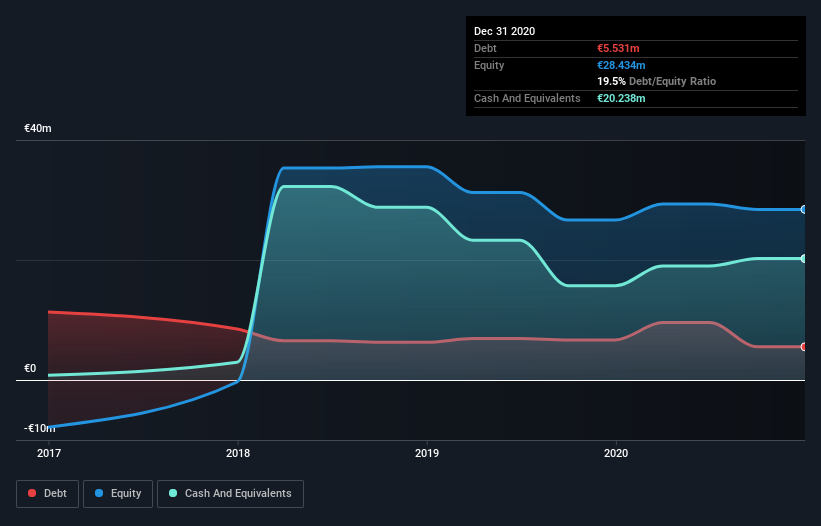
Legendary fund manager Li Lu (who Charlie Munger backed) once said, 'The biggest investment risk is not the volatility of prices, but whether you will suffer a permanent loss of capital.' When we think about how risky a company is, we always like to look at its use of debt, since debt overload can lead to ruin. As with many other companies Kalray S.A. (EPA:ALKAL) makes use of debt. But is this debt a concern to shareholders?
Why Does Debt Bring Risk?
Debt is a tool to help businesses grow, but if a business is incapable of paying off its lenders, then it exists at their mercy. If things get really bad, the lenders can take control of the business. However, a more frequent (but still costly) occurrence is where a company must issue shares at bargain-basement prices, permanently diluting shareholders, just to shore up its balance sheet. By replacing dilution, though, debt can be an extremely good tool for businesses that need capital to invest in growth at high rates of return. The first step when considering a company's debt levels is to consider its cash and debt together.
See our latest analysis for Kalray
How Much Debt Does Kalray Carry?
As you can see below, Kalray had €5.53m of debt at December 2020, down from €6.68m a year prior. However, its balance sheet shows it holds €20.2m in cash, so it actually has €14.7m net cash.

A Look At Kalray's Liabilities
The latest balance sheet data shows that Kalray had liabilities of €4.26m due within a year, and liabilities of €14.8m falling due after that. Offsetting this, it had €20.2m in cash and €2.69m in receivables that were due within 12 months. So it can boast €3.86m more liquid assets than total liabilities.
Having regard to Kalray's size, it seems that its liquid assets are well balanced with its total liabilities. So it's very unlikely that the €209.1m company is short on cash, but still worth keeping an eye on the balance sheet. Simply put, the fact that Kalray has more cash than debt is arguably a good indication that it can manage its debt safely. When analysing debt levels, the balance sheet is the obvious place to start. But it is future earnings, more than anything, that will determine Kalray's ability to maintain a healthy balance sheet going forward. So if you're focused on the future you can check out this free report showing analyst profit forecasts.
In the last year Kalray had a loss before interest and tax, and actually shrunk its revenue by 58%, to €3.2m. To be frank that doesn't bode well.
So How Risky Is Kalray?
We have no doubt that loss making companies are, in general, riskier than profitable ones. And we do note that Kalray had an earnings before interest and tax (EBIT) loss, over the last year. Indeed, in that time it burnt through €16m of cash and made a loss of €12m. However, it has net cash of €14.7m, so it has a bit of time before it will need more capital. Even though its balance sheet seems sufficiently liquid, debt always makes us a little nervous if a company doesn't produce free cash flow regularly. When analysing debt levels, the balance sheet is the obvious place to start. But ultimately, every company can contain risks that exist outside of the balance sheet. Case in point: We've spotted 3 warning signs for Kalray you should be aware of.
If you're interested in investing in businesses that can grow profits without the burden of debt, then check out this free list of growing businesses that have net cash on the balance sheet.
When trading Kalray or any other investment, use the platform considered by many to be the Professional's Gateway to the Worlds Market, Interactive Brokers. You get the lowest-cost* trading on stocks, options, futures, forex, bonds and funds worldwide from a single integrated account. Promoted
Valuation is complex, but we're here to simplify it.
Discover if Kalray might be undervalued or overvalued with our detailed analysis, featuring fair value estimates, potential risks, dividends, insider trades, and its financial condition.
Access Free AnalysisThis article by Simply Wall St is general in nature. It does not constitute a recommendation to buy or sell any stock, and does not take account of your objectives, or your financial situation. We aim to bring you long-term focused analysis driven by fundamental data. Note that our analysis may not factor in the latest price-sensitive company announcements or qualitative material. Simply Wall St has no position in any stocks mentioned.
*Interactive Brokers Rated Lowest Cost Broker by StockBrokers.com Annual Online Review 2020
Have feedback on this article? Concerned about the content? Get in touch with us directly. Alternatively, email editorial-team (at) simplywallst.com.
About ENXTPA:ALKAL
Slight with mediocre balance sheet.
Market Insights
Community Narratives



